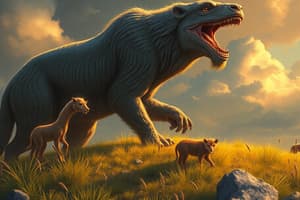Podcast
Questions and Answers
What is a common characteristic of species that are more vulnerable to extinction?
What is a common characteristic of species that are more vulnerable to extinction?
- Ecological specialization (correct)
- High population sizes
- Evolutionary stability over millions of years
- Geographical distribution across multiple continents
What is believed to have caused the Permian-Triassic Extinction?
What is believed to have caused the Permian-Triassic Extinction?
- A global pandemic
- A combination of evolutionary factors and random events
- A single massive asteroid impact
- Climate change and associated ocean acidification, along with massive volcanic eruptions (correct)
What percentage of marine species went extinct during the Permian-Triassic Extinction?
What percentage of marine species went extinct during the Permian-Triassic Extinction?
- 75%
- 80%
- 50%
- 96% (correct)
What is believed to have caused the K-Pg Extinction?
What is believed to have caused the K-Pg Extinction?
What is a potential effect of a large asteroid impact?
What is a potential effect of a large asteroid impact?
What is a characteristic of massive volcanic eruptions that can contribute to mass extinctions?
What is a characteristic of massive volcanic eruptions that can contribute to mass extinctions?
Which of the following is an example of a massive volcanic eruption that contributed to a mass extinction?
Which of the following is an example of a massive volcanic eruption that contributed to a mass extinction?
What is the name of the asteroid impact that is believed to have contributed to the K-Pg Extinction?
What is the name of the asteroid impact that is believed to have contributed to the K-Pg Extinction?
Flashcards are hidden until you start studying
Study Notes
Causes of Extinction
- Multiple factors contribute to mass extinctions, including:
- Environmental stressors (e.g., climate change, sea-level changes)
- Evolutionary factors (e.g., species competition, adaptation)
- Random events (e.g., asteroid impacts, volcanic eruptions)
- Species vulnerability plays a crucial role in mass extinctions, with species that are:
- Ecologically specialized
- Geographically restricted
- Having low population sizes
- Being evolutionary novelties being more prone to extinction
Permian-Triassic Extinction (PT Extinction)
- Also known as the "Great Dying"
- Occurred around 252 million years ago
- Causes:
- Massive volcanic eruptions in Siberia (Siberian Traps)
- Climate change and associated ocean acidification
- Possible asteroid impact
- Effects:
- 96% of marine species and 70% of terrestrial species went extinct
- Most families of life were severely impacted or went extinct
- Recovery took millions of years
K-Pg Extinction (Cretaceous-Paleogene Extinction)
- Occurred around 65 million years ago
- Causes:
- Asteroid impact (Chicxulub asteroid impact)
- Global wildfires
- Massive volcanic eruptions (Deccan Traps)
- Effects:
- 75% of species, including non-avian dinosaurs, went extinct
- Marks the end of the Cretaceous period and the beginning of the Paleogene period
Asteroid Impacts
- Large asteroid impacts can cause massive destruction and global cooling, leading to mass extinctions
- Examples:
- Chicxulub asteroid impact (K-Pg Extinction)
- Vredefort impact ( Possible contributor to the Permian-Triassic Extinction)
- Effects:
- Shock waves and tsunamis
- Global firestorms
- Long-term climate disruption
Massive Volcanic Eruptions
- Large-scale volcanic eruptions can release massive amounts of toxic gases, causing global cooling and acid rain, which can lead to mass extinctions
- Examples:
- Siberian Traps (Permian-Triassic Extinction)
- Deccan Traps (K-Pg Extinction)
- Effects:
- Global cooling
- Acid rain
- Reduced sunlight
- Disruption of food chains
Causes of Extinction
- Multiple factors contribute to mass extinctions, including environmental stressors, evolutionary factors, and random events.
- Species vulnerability plays a crucial role in mass extinctions, especially for species that are ecologically specialized, geographically restricted, have low population sizes, or are evolutionary novelties.
Permian-Triassic Extinction (PT Extinction)
- Occurred around 252 million years ago and is also known as the "Great Dying".
- Massive volcanic eruptions in Siberia (Siberian Traps) and climate change with associated ocean acidification were the likely causes.
- Possible asteroid impact also contributed to the extinction.
- 96% of marine species and 70% of terrestrial species went extinct, with most families of life severely impacted or gone extinct.
- Recovery took millions of years.
K-Pg Extinction (Cretaceous-Paleogene Extinction)
- Occurred around 65 million years ago.
- The Chicxulub asteroid impact, global wildfires, and massive volcanic eruptions (Deccan Traps) were the likely causes.
- 75% of species, including non-avian dinosaurs, went extinct, marking the end of the Cretaceous period and the beginning of the Paleogene period.
Asteroid Impacts
- Large asteroid impacts can cause massive destruction and global cooling, leading to mass extinctions.
- Examples include the Chicxulub asteroid impact (K-Pg Extinction) and the Vredefort impact (possible contributor to the Permian-Triassic Extinction).
- Effects include shock waves and tsunamis, global firestorms, and long-term climate disruption.
Massive Volcanic Eruptions
- Large-scale volcanic eruptions can release massive amounts of toxic gases, causing global cooling and acid rain, which can lead to mass extinctions.
- Examples include the Siberian Traps (Permian-Triassic Extinction) and the Deccan Traps (K-Pg Extinction).
- Effects include global cooling, acid rain, reduced sunlight, and disruption of food chains.
Studying That Suits You
Use AI to generate personalized quizzes and flashcards to suit your learning preferences.



